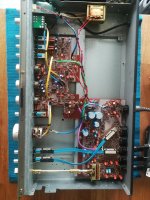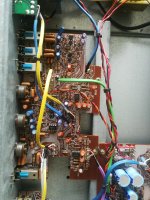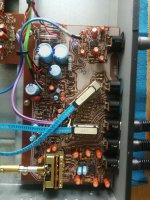Hello,
Its an amp form 70s, TEC System 5000 (supposedly Toshiba Electric Corporation.) Pream + power amp.
This morning a high gain condenser mic feedback happened and it got quite loud. The mic signal came through an external audio mixer output inthe the preamp's RCA input.
After the event it seemed the right channel is dead, but then I discovered that it plays just at very low volume compared to the left one. The two power meters also show different power levels.
Not sure if the power amp has any a speaker protection system (ie relay) except a electrolyte capacitor in the center point of NPN and PNP transistor between two 0.33 ohm resistors. Im not wrong about the capacitor.
It seems to me that the power transistors are operational.
Can you suggest what to check next or perhaps you can already assume whats the oroblem.
Thanks
Rando
Its an amp form 70s, TEC System 5000 (supposedly Toshiba Electric Corporation.) Pream + power amp.
This morning a high gain condenser mic feedback happened and it got quite loud. The mic signal came through an external audio mixer output inthe the preamp's RCA input.
After the event it seemed the right channel is dead, but then I discovered that it plays just at very low volume compared to the left one. The two power meters also show different power levels.
Not sure if the power amp has any a speaker protection system (ie relay) except a electrolyte capacitor in the center point of NPN and PNP transistor between two 0.33 ohm resistors. Im not wrong about the capacitor.
It seems to me that the power transistors are operational.
Can you suggest what to check next or perhaps you can already assume whats the oroblem.
Thanks
Rando
Attachments
If the outputs are good, you need to check drivers and the nearby resistors. What else have you checked up to now? Is the power supply working and the same on both channels?
I havent checked the driver circuits as Im not sure how to determine these on the board.
Ive checked the emitter-collector voltages 34V and base-emitter voltage drops 0.49V
Between the centre point (of emitter and the 0.33ohm resitors) and the ground is also 34V for both channels.
Ive checked the emitter-collector voltages 34V and base-emitter voltage drops 0.49V
Between the centre point (of emitter and the 0.33ohm resitors) and the ground is also 34V for both channels.
With the power off, check using diode mode on your DMM. Google NPN diode check if unfamiliar of the steps.
If you have full rail voltage on the emitter, you have one or more shorted outputs, and you are likely hearing the drivers at high volume. Your emitter should have close to 0 DC and an AC voltage that goes up and down based on the volume of you input signal (volume knob)
If you have full rail voltage on the emitter, you have one or more shorted outputs, and you are likely hearing the drivers at high volume. Your emitter should have close to 0 DC and an AC voltage that goes up and down based on the volume of you input signal (volume knob)
I was cheking the instructions below and I wrote the reading onto the paper, see the pic:
Testing transistors with a voltmeter
https://vetco.net/blog/test-a-transistor-with-a-multimeter/2017-05-04-12-25-37-07
How to Test Transistors with a Multimeter - NPN, PNP, JFET - YouTube
Testing transistors with a voltmeter
https://vetco.net/blog/test-a-transistor-with-a-multimeter/2017-05-04-12-25-37-07
How to Test Transistors with a Multimeter - NPN, PNP, JFET - YouTube
Attachments
Perhaps one of the input op-amps or transistor got zapped.I discovered that it plays just at very low volume compared to the left one.
Try to feed some small signal at the Vol pot viper to rule out the power amp.
Touch it with Your finger. Same hum volume on both channels ?
I havent yet had a chance to dive into the drivers of the power amp nor into the preamp, but here are some pics of the preamp.
Based on the pics is it possible for you to point out what should I check first?
Based on the pics is it possible for you to point out what should I check first?
Attachments
If you can follow the signal in with a multimeter on AC volts (ideally a signal generator on the input, but a mains buzz from your fingers might suffice).
The channels should match each other, you may be able to narrow down where the discrepancy happens by comparing left to right circuits, and thus narrow down to a particular part of the amp.
The channels should match each other, you may be able to narrow down where the discrepancy happens by comparing left to right circuits, and thus narrow down to a particular part of the amp.
- Home
- Amplifiers
- Solid State
- One amp channel plays low after mic feedback event
![IMG_20210506_122512[1].jpg](/community/data/attachments/862/862149-c7c9e555515178033cb1bcc4098cbd72.jpg?hash=x8nlVVFReA)
![IMG_20210506_092618[1].jpg](/community/data/attachments/862/862170-f392a2080c7688201ea810160b639b4d.jpg?hash=85KiCAx2iC)
![IMG_20210507_005104[1].jpg](/community/data/attachments/863/863284-75596f52e0ceea4c352af09a59eb2d2b.jpg?hash=dVlvUuDO6k)


